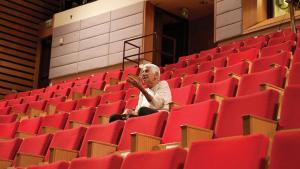
Tackling Water Scarcity Through AI
Amal Esawi’s latest research employs AI and nano-enhanced materials to improve membranes used in desalination as a means of tackling water scarcity
Professor Amal Esawi ’89, ’90, the first Egyptian woman mechanical engineer to be chartered in the United Kingdom and the first scientist in Egypt to specialize in nanotubes, is making waves in the field of nanocomposites, leading a project that utilizes the power of AI to enhance water desalination membranes.
“We’re finding sustainable solutions to water scarcity through the use of novel, nano-enhanced membranes,” said Esawi, who is principal investigator of this project, which is managed by AUC's Center of Excellence for Water, funded by the United States Agency for International Development and implemented in collaboration with Ain Shams University. “AI tools, such as Artificial Neural Networks, can help us in optimizing the membrane itself and building models that predict how it will perform when operating for a long period under different conditions. Our ultimate goal is to improve and strengthen the membrane’s structure and performance, leading to a more efficient desalination process."
These nano-enhanced membranes use materials like carbon nanotubes that help increase structural integrity and filtration efficiency. They also offer better performance by aiding in capturing finer particles and enabling effective purification during the water desalination process.
Nanomaterials, particularly nanocarbons, first caught Esawi’s attention for their robustness and lightness. "My initial focus in nanotechnology was centered on utilizing carbon nanotubes to engineer lighter and stronger materials,” she explained. “Upon discovering their potential in desalination membranes, I pivoted my research toward enhancing filtration applications.”
Egypt is currently investing in desalination plants to address water scarcity in the region. Esawi asserts the need to not just innovate membranes but also localize their production to potentially reduce costs. “Because membranes are the most critical component in the desalination plant, they are imported from the United States or Japan. Building the local know-how of membrane manufacturing will be very useful and valuable for Egypt,” she said.
The two-year project is still in its early stages, but Esawi is optimistic about its potential impact on desalination technology.
“This project could lay the foundations for the local production of advanced nano-enhanced membranes, benefiting not only Egypt but also other regions facing water scarcity,” she said.
Esawi presented the project, “Using AI Tools to Optimize the Development of Novel Nano-enhanced Membranes for Water Desalination,” at the Second International Symposium on Water Research, organized by AUC’s Center of Excellence for Water in collaboration with Ain Shams University in late 2023. Mohammed El Morsi, mechanical engineering professor, and Adham Ramadan ’90, chemistry professor, dean of graduate studies and associate provost for research innovation and creativity, are co-principal investigators of the project with Esawi. El Morsi emphasized the power of membrane technology. “It has emerged as a more energy-efficient and cost-effective alternative to thermal desalination techniques,” he said. “By utilizing AI tools to optimize the process, we are hoping to further reduce energy consumption.”
Besides her innovative research in water desalination, Esawi was recognized as one of the top 2% impactful scientists globally, named in the Stanford-Elsevier's Scopus database as one of the most cited scientists. Hoping to inspire her students and other women engineers in Egypt, she expressed pride in witnessing an AUC graduate, Sarah Hussein ’07, become the second female Egyptian mechanical engineer to be chartered in the United Kingdom. “I am humbled to pave the way for aspiring engineers in Egypt, especially women,” she said.




